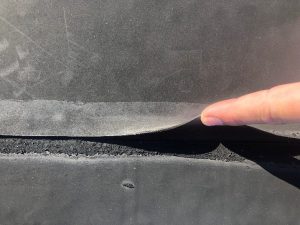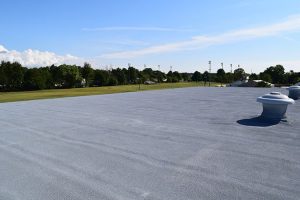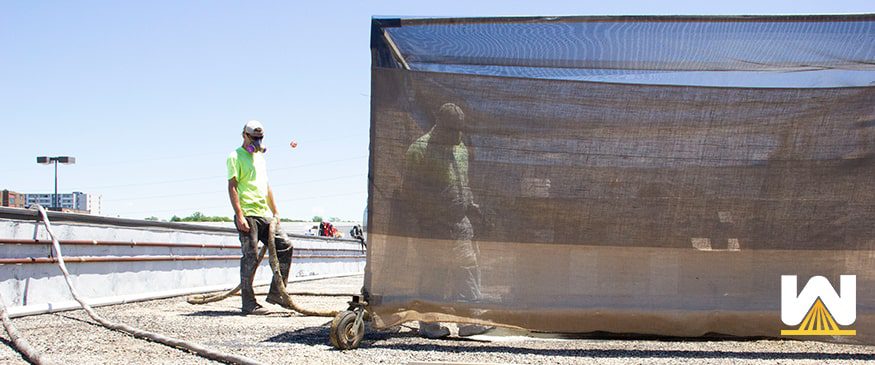As a property owner, your #1 priority is to keep your lot 100% occupied with companies that pay their rent on time.
As a building owner, your #1 priority is to generate profits, which is done by having a great product or service and loyal employees who do great work.
Having a commercial roof that leaks lowers your chances of these two scenarios happening.
Why?
If you owned a mom and pop pizza place in a complex and your roof constantly leaks, you probably complain to the property owner about the roof leaking. Maybe it gets fixed, maybe it doesn’t.
After a few months of dealing with this extra headache, you decide to move to another complex.
If you’re an employee of a company that has a leaking roof, perhaps there are added safety hazards that are in place, such as water near electric outlets, mold forming, etc.
After a year, you think the place your work at (which is associated with your company) is a dump and you begin to look for other opportunities.
No one deserves to live, work, or spend any time under a roof that leaks.
Perhaps you never thought it was a big deal?
West Roofing Systems has been relieving building owners of their roofing headaches since 1979. Every situation is different, every solution is different, but the problems that a leaking roof creates are usually one of the four options you’ll find in this article.
Today we’re going to describe four problems that leaking roofs create.
Let’s begin.
Problem #1 – Employees and Businesses leave
If you hired somebody, or if you came into an agreement for a business to move into your complex, how great is it when everything goes smoothly?
Work gets done, rent gets paid, it’s exactly how you envisioned everything going.
But what if I told you that a leaking roof can damage how “everything is going?”
Employees or businesses do not want to work in dumps. They find a roof that leaks to be an unsatisfactory roofing condition that they won’t accept working in.
How long will they deal with a leaking roof before moving on to something else? That’s hard to tell.
But I think it’s safe to say that if the problem is never fixed, or new leaks start once others are fixed, that person’s vision of the workplace is weakened, which leads to the curiosity of other opportunities.
NOTE: According to Forbes, it costs 5x more to attract a new customer than to keep an old one. It may not be the same for employee or business retention, but it can’t be far off.
Problem #2 – A roof leak is a constant headache for the building owner
If you’re a building owner, you probably have a million things going on.
Now add these phone calls to the list:
“There are brown spots all over the ceiling, is water going to come through soon?”
“When is this leak going to be fixed?”
And then the next day…
“Hi, you never returned my call about the roof leak.”
“I don’t have enough buckets to catch all this water, help!”
Simply put, a roof leak is a headache that can be eliminated. But if you don’t take care of the problem, your tenants will become a nightmare, wasting your time that could be put towards ANYTHING ELSE!
Problem #3 – A roof leak can damage assets
Water entering a building can damage all kinds of assets.
Water can drip into any kind of machine and damage it.
Imagine a few drops damaging equipment worth millions of dollars. It’s not common, but it’s happened.
Now instead of money, what if a major roof leak damaged personal items of an employee; perhaps a photo of a loved one that passed.
How much is that picture worth?
A few drops may not seem like a lot, but once some water can enter a building, one more rainstorm that lasts hours can bring in a tremendous amount of water.
What about a computer room, server room, or audio/visual equipment? These items are not cheap and are highly sensitive to water damage.
If any of these assets are damaged, is that company going to have enough money to pay the rent? Are you liable in the contract of replacing these items if the roof leaks?
A roof leak is no good for anybody.
When assets are damaged because of an issue that should’ve never happened, it’s an unfortunate event.
Problem #4 – A roof leak creates a safety hazard
It’s no secret that water dripping on the floor creates safety hazards with slipping. But what if an employee slips and sustains a permanent injury?
Someone is going to be on the hook for that, and that’s not going to be an easy (or cheap) settlement.
What about water leaking near electrical outlets? Water and electricity certainly don’t mix well.
What about water that stays in your walls for a certain amount of time which creates mold?
Those scenarios can cost thousands of dollars to fix.
Let’s shift gears.
Now that we’ve looked at a few problems that a leaking commercial roof can cause, how do we fix it?
Very simply, you install a roofing system that does not leak, such as spray foam.
What properties of a spray foam roofing system prevent roof leaks?
There are three main reasons why a spray foam roof will not leak, they include:
- Spray foam is closed-cell
- Spray foam does not have any seams
- Spray foam encapsulates penetrations
Before we begin, to prevent a leaking roof, proper preparation needs to take place before ANY type of roofing system is installed.
This is done with a roof inspection and an infrared inspection. The purpose of these two is to identify the current condition of the roof, the flow of water off of the roof, and to identify saturation in the roof’s insulation, which will show where water is currently in your system.
Once the saturated areas are identified, these need to be removed and replaced with similar material as the rest of the roof.
Now that we have a dry roof, and there’s been proper preparation to the existing roof (such as cleaning the roof and possibly using a cover board), a spray foam installation can begin.
A spray foam roof is closed-cell
Spray foam is a combination of two chemicals, which when heated and mixed correctly, expand to 30 times its size within minutes, forming a material that’s about 1.5 inches in thickness.
In the 1.5 inches, are millions of tiny molecules that are closed-cell.
Closed-cell means that water cannot travel horizontally throughout the roof.
This is different from other types of roof insulation, which when wet, the water can travel horizontally, further expanding the amount of saturation.
If a spray foam roof gets a crack or a hole, the water will sit in that area until it’s dried out.
A spray foam roof does not have any seams
A common area where leaks occur is near a seam. This is because seams are fastened or glued together, which that bond can break down and wear away over time.
Once the seams are separated, water has easy access to your insulation.

A spray foam roof is spray-applied, meaning there are no seams. The entire roof is one layer.

Spray foam encapsulates penetrations
Another common area where leaks occur is near a penetration. A penetration is anything that “penetrates” through the roof.
The most common penetrations are skylights, vents, exhausts, and HVAC units.
Traditional roofing systems need to use boots or covers that go around a pipe, and then custom cut their roofing membrane to fit around the boot.
As you can guess, there’s lots of cutting and fitting multiple pieces together, which creates an easy path for water to enter your insulation if any of those pieces separate.
A spray foam roof is all one layer, including the penetrations.
Here’s a video of spray foam going around a cardboard box, simulating a curb on a roof:
People deserve to live and work in a leak-free environment
Dealing with roofing issues is no doubt a headache that no building owner wants to deal with. But hopefully, after this read, you can see that roofing leaks can lead to serious damages.
And now that you know the benefits of installing a spray foam roof, what are your next steps?
You can go two ways:
- Request a quote. After you fill out a form, we’ll contact you to get to know you and your roofing issues and to see what roofing options you have.
- Learn more about spray foam roofing. We developed an eBook (you don’t need to give us any information to read it) that answers common spray foam roofing questions, such as cost, problems, etc.


